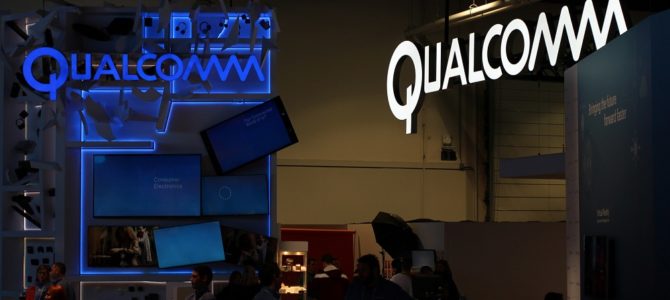
In a recent opinion article, my friend Geoff Manne claims that the Federal Trade Commission’s case against Qualcomm risks doing “more to undermine intellectual property rights” than any past commission has. I disagree, as the FTC lawsuit (and Apple’s separate case) protects both competition and innovation.
In January 2017, the FTC sued Qualcomm in Federal District Court in San Jose, California. At a trial a year later, the commission argued that the company has used its dominant market position to strong-arm competitors and customers, threatening to cut off the supply of its chips if equipment makers do not agree to its terms, and refusing to honor its contractual obligation to negotiate reasonable prices for its industry-standard chips. While it has not denied engaging in the business practices at issue, Qualcomm has vigorously denied those practices violate antitrust laws. The parties now await a ruling from Judge Lucy Koh.
The trial has exposed mutually reinforcing Qualcomm practices that suppress competition in premium cellular modem chips. By threatening to cut off supply, Qualcomm uses its dominant position to require customers to license patents embodied in the chips. This “no license, no chips” policy raises rivals’ costs and harms consumers.
Qualcomm’s coerced royalties also far exceed the innovative value of its intellectual property. Indeed, Qualcomm extracts more in royalties than do all of the other cellular patent holders combined.
These practices do not promote innovation. Instead, Qualcomm has repeatedly harmed innovation, as when it conditioned royalty abatement on Apple’s abandonment of the 4G WiMAX technology in favor of earlier generation cellular technology.
An Explanation of Voluntary Standard-Setting
Understanding the technology market in which the FTC seeks to promote competition requires understanding voluntary standard setting organizations (SSOs)—one of the most important free-market institutions for innovation. The U.S. patent system is a foundation of the economy, encouraging innovation and growth. Although conservatives are rightly concerned that property rights be protected adequately, especially internationally, the patent system is hardly perfect.
The economy is awash in low-quality patents, and the cumulative and complementary nature of innovation can cause a patent “thicket” that impedes innovation rather than creating property rights that protect actual innovation. These problems can cripple an industry agreeing to uniform product standards that, once adopted, allow patent holders to claim a royalty, not for the inventive value of the patent, but for the extra value the patent gains when an industry standard forces all manufactures to use it.
Recognizing the potential for harm, SSOs contracted regarding various aspects of patent law and required patent holders to make pro-competitive commitments include FRAND promises, which require both nondiscriminatory licenses and royalty demands consistent with the competitive conditions when the standard was set. (Crucially, Manne and I both agree that Qualcomm should follow its FRAND promises.) The explosive growth of the smartphone industry resulted from the creation of the uniform technology standards the SSOs embraced and advanced.
Viewed through this lens with the exclusionary conduct discussed below, the FTC’s and Apple’s cases against Qualcomm are well justified, challenging practices that are unique in the semiconductor industry.
How Qualcomm Unfairly Inflates Its Royalties
Every other company that makes chips and other component technology sells its products for one all-inclusive price, recovering the value of its innovations in that price. Qualcomm differs, requiring smartphone makers to pay for chips and a separate licensing fee that is effectively a percentage of smartphone sales revenue.
Qualcomm refuses to sell its chips to companies that will not pay those inflated royalties. No other technology company does this. The trial evidence shows that because of Qualcomm’s threats to cut chip supplies, smartphone manufacturers had no choice but to cave to Qualcomm and pay much higher prices.
Qualcomm’s breach of its contractual obligation to negotiate licenses free of this coercion also burdens competitors. If the FTC is correct, then there has been less innovation and higher smartphone prices than would have occurred absent the conduct.
The competitive harm from this “no-license, no-chips” policy is apparent. The table below illustrates how Qualcomm’s unique policy raises rivals’ costs. In this illustration, the FRAND price for Qualcomm’s intellectual property in the industry standards for chips is $3. Under competition, following the SSO’s terms, Qualcomm collects the patents’ value on all modem sales (either its own or competitors) that incorporate those patents.

Qualcomm’s no-license, no-chips policy reverses this competitive result. By forcing each customer to license its technology or risk losing chipset supply, Qualcomm shifts a portion of the chip price to its royalty, and inflates the total (“all in”) price of competitors’ modem chips. (The customer will have to pay the inflated royalty for chipsets sold by either Qualcomm or its competitors, if both incorporate the Qualcomm patents).
By shifting part of its chip price to the royalty, $15 in the example, Qualcomm obtains a price advantage over its competitors that is unrelated to competitive merits. Because of the no-license, no-chips policy, manufacturers face the catastrophic risk of no supplies and may reluctantly agree to Qualcomm’s demands. Qualcomm’s chipset competitors, who cannot reduce their prices as did Qualcomm, are disadvantaged, reducing innovation and, in the extreme, exiting the market.
This Is What the Case Is All About
Qualcomm’s ability to manipulate the marketplace lies at the heart of the FTC’s case. The end result is evasion of FRAND, the precise outcome the SSO agreements were designed to irradiate. As noted by Joe Simons—appointed by President Trump as FTC chairman—and Bruce Hoffman, director of the FTC’s Bureau of Competition, practices that “violates or subverts rules governing an SSO” can well violate the antitrust laws. They explain, correctly, that “conduct that violates the rules of an SSO is likely, in general, to reduce output by deterring participation in or raising the cost of standard-setting activities, and violating rules, although it may permit the violator to extract rents from other parties, does not enhance competitive efficiency.”
Here, Qualcomm benefits initially from having its technology incorporated into industry standards, then uses its market power and no-license, no-chips practice to subvert FRAND rules, and exclude competitors. All the well-known problems that SSOs sought to avoid with FRAND naturally follow, including less innovation, reduced options, and higher prices.
Manne nonetheless raised multiple objections to the case against Qualcomm. First, the “most fundamental” issue in his view is the “no duh” problem: “Of course Qualcomm conditions the purchase of its chips on the licensing of its intellectual property; how could it be any other way?” Yet the rest of the world functions quite satisfactorily without the unique no-license, no-chips policy at issue here.
No other technology company in any industry forces its customers both to pay for its product and for a separate license to the patents contained therein. Rather, they earn a competitive return on their intellectual property in the single, all-in price. Indeed, even Qualcomm avoids its policy outside the cellular field, in which it wields outsized market power.
Qualcomm’s Practices Are Highly Anti-Competitive
Second, Manne finds “fanciful” the idea that Qualcomm held sufficient market power for its conduct to be anti-competitive, citing competitors like Samsung and Intel. All antitrust monopolists face some competition. In my experience, all companies accused of monopolizing cast their marketplace as “fiercely competitive” and threatened by “new entry” by household names.
In any event, the trial produced some compelling evidence. The key market is for premium modems with two parts, the premium system on a chip and premium thin-modems. In the first segment, Qualcomm has no competitors and only a single competitor (Intel) in the second with a fragile market position. Many customers testified that they bent to Qualcomm’s licensing demands only because of the threat of losing access to Qualcomm’s modem chips.
Moreover, Qualcomm collects more royalties than all other industry patent holders combined, while its portfolio does not come close to even one-quarter of the relevant standard-essential patents either in number or quality. The FTC reported that Qualcomm itself recognizes it earned a stunning 25 percent of global patent licensing revenue, not just in the modem chip industry, but in all industries worldwide.
Finally, Manne challenges the key assumption at the heart of the FTC case, that Qualcomm uses its unique no-license, no-chips policy to extract patents at supra-FRAND terms. Citing the FTC’s expert, “[R]oyalties that are or would be negotiated ex ante with full information are a market bench-mark reflecting legitimate return to innovation.” Qualcomm has long argued that pre-standard 5 percent royalty terms have not changed over time.
But this point supports the FTC, not Qualcomm. The 5 percent royalty is based on the price of the smartphone, whose price now includes new features unrelated to Qualcomm’s intellectual property. For example, consumers pay for improved displays, storage, or facial recognition; yet Qualcomm’s royalty terms capture 5 percent of that increased value, which has nothing to do with Qualcomm’s patents. Without market power, Qualcomm’s royalties should decrease as less of the value reflects Qualcomm’s contributions.
Similarly, one amicus brief notes that Qualcomm earns more than four times the amount of cellular royalties that Ericsson does, even though the two companies have a comparable number of novel SEPs for the 4G LTE protocol. Again, this fact suggests Qualcomm’s royalty rates are inconsistent with FRAND.
In the end, the FTC applied established antitrust principles and charged Qualcomm with using monopoly power to raise prices for key components in Apple’s iPhone and similar devices. If the federal court finds that the evidence supports the FTC, it will likely end Qualcomm’s practice of demanding royalties through this extortive no-license, no-chips policy. Based on the testimony and evidence, that certainly would be a victory for American inventors and consumers.









